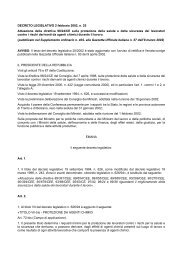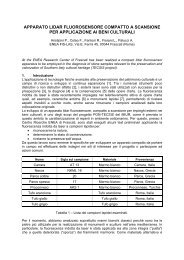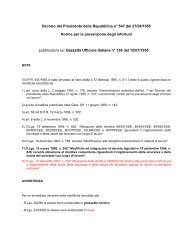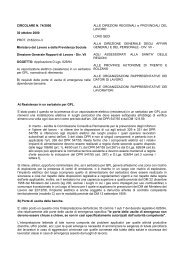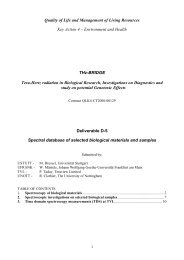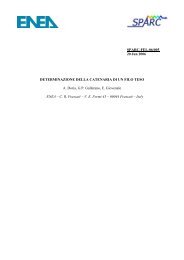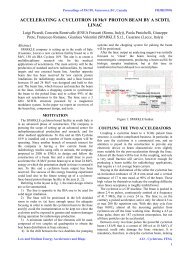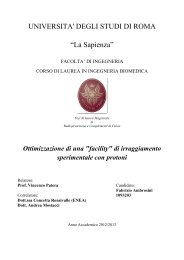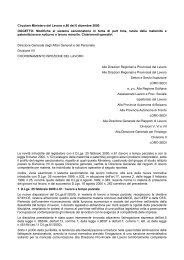Theory, Design and Tests on a Prototype Module of a Compact ...
Theory, Design and Tests on a Prototype Module of a Compact ...
Theory, Design and Tests on a Prototype Module of a Compact ...
Create successful ePaper yourself
Turn your PDF publications into a flip-book with our unique Google optimized e-Paper software.
CHAPTER 5<br />
Radi<strong>of</strong>requency Measurement<br />
In this chapter a detailed descripti<strong>on</strong> <strong>of</strong> the radi<strong>of</strong>requency (RF)<br />
measurement performed <strong>on</strong> LIBO prototypes is presented. RF measurement<br />
are very important <strong>on</strong> this type <strong>of</strong> structures, since they are<br />
the <strong>on</strong>ly way to correct the unavoidable errors that are mirrors <strong>of</strong> the<br />
mechanical machining tolerances. Note that the errors we have dealings<br />
with can big enough to need a correcti<strong>on</strong> to get the desired design value<br />
for the main electromagnetic parameters, even if they are very small<br />
(for example, the frequency error <strong>of</strong> each cavity is typically included<br />
within the 0.1%).<br />
In the following, each secti<strong>on</strong> begins with an overview <strong>on</strong> the technique,<br />
the instruments <str<strong>on</strong>g>and</str<strong>on</strong>g> the tools used for the specific measurement<br />
explained: single cavity <str<strong>on</strong>g>and</str<strong>on</strong>g> coupled cavities measurement are presented,<br />
<str<strong>on</strong>g>and</str<strong>on</strong>g> for each type <strong>of</strong> measurement, specific tasks for LIBO are<br />
illustrated. The tuning procedure to obtain a flat l<strong>on</strong>gitudinal electric<br />
field for the whole LIBO module is also presented.<br />
1. Introducti<strong>on</strong><br />
In the analysis <strong>of</strong> structures where the geometrical dimensi<strong>on</strong>s are<br />
comparable with the wavelength <strong>of</strong> the electromagnetic signals, it is<br />
correct to use the c<strong>on</strong>cept <strong>of</strong> reflected <str<strong>on</strong>g>and</str<strong>on</strong>g> transmitted waves rather<br />
then currents <str<strong>on</strong>g>and</str<strong>on</strong>g> voltages, since propagati<strong>on</strong> effects become very important.<br />
In this frame, the parameters <strong>of</strong> interest are the scattering parameters,<br />
namely the reflecti<strong>on</strong> <str<strong>on</strong>g>and</str<strong>on</strong>g> the transmissi<strong>on</strong> coefficients [33].<br />
The sequence <strong>of</strong> RF measurement to perform is quite the opposite<br />
<strong>of</strong> the <strong>on</strong>e used for the design. Indeed, the tiles with two half cavities<br />
are normally the first pieces built <str<strong>on</strong>g>and</str<strong>on</strong>g> then the first measurement is<br />
<strong>on</strong> the single cavities. In figure 5.1 it is shown a flux diagram <strong>of</strong> the<br />
procedures adopted with LIBO to build up the module, involving both<br />
measurement <str<strong>on</strong>g>and</str<strong>on</strong>g> machining <strong>on</strong> the copper pieces.<br />
First, as we said, <strong>on</strong>e starts from the measurement <strong>on</strong> the tiles,<br />
as they come out from the mechanical workshop. On these pieces<br />
three types <strong>of</strong> measurement are performed: coupled cells measurement<br />
giving coupling coefficients <str<strong>on</strong>g>and</str<strong>on</strong>g> res<strong>on</strong>ant frequencies, single frequency<br />
measurement <str<strong>on</strong>g>and</str<strong>on</strong>g> stacked cell measurement that gives the π/2 mode<br />
frequency <str<strong>on</strong>g>and</str<strong>on</strong>g> the stop-b<str<strong>on</strong>g>and</str<strong>on</strong>g> amplitude. If the values are not correct<br />
<str<strong>on</strong>g>and</str<strong>on</strong>g>/or present a large dispersi<strong>on</strong> around the design values, <strong>on</strong>e can<br />
67







